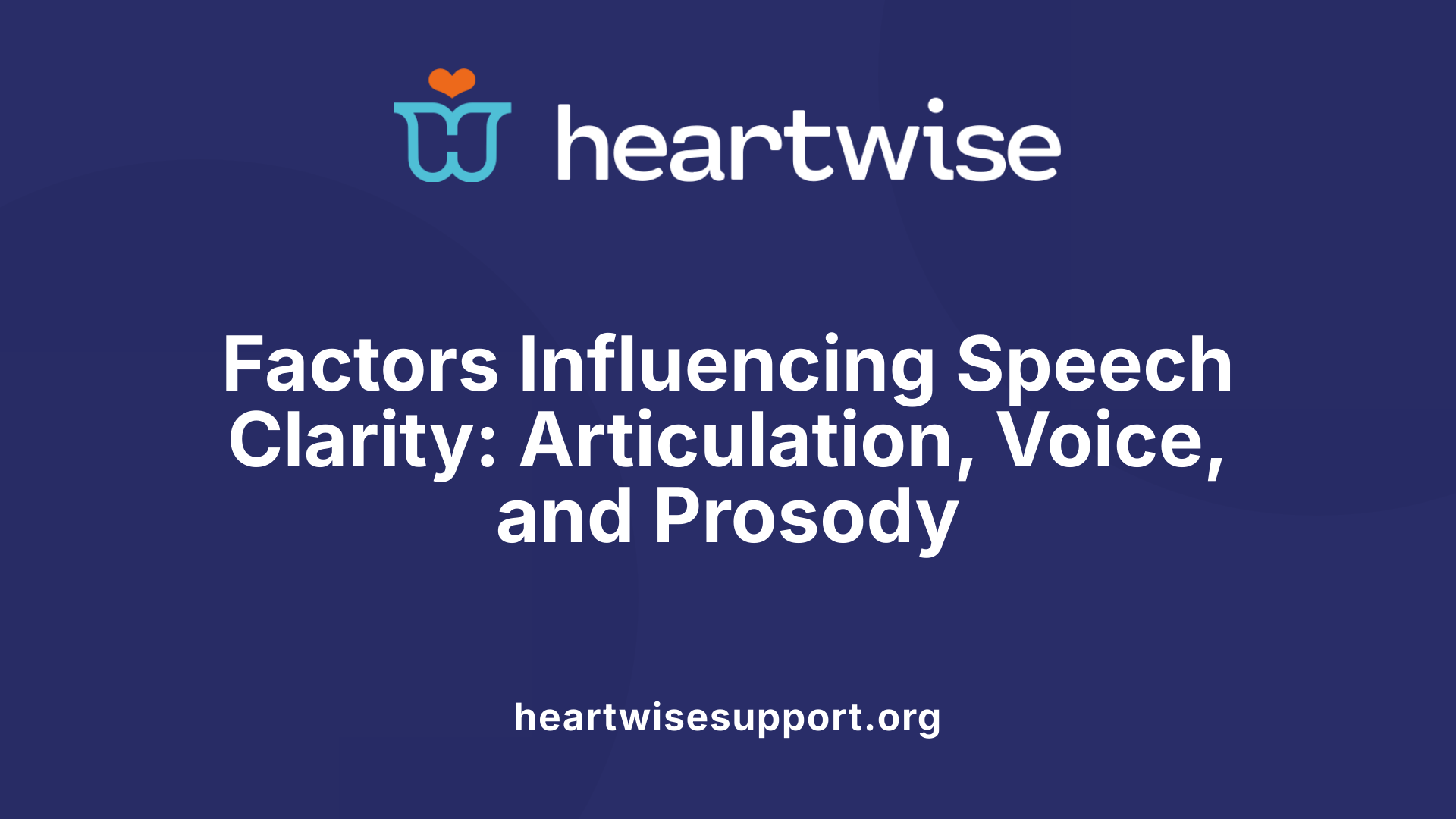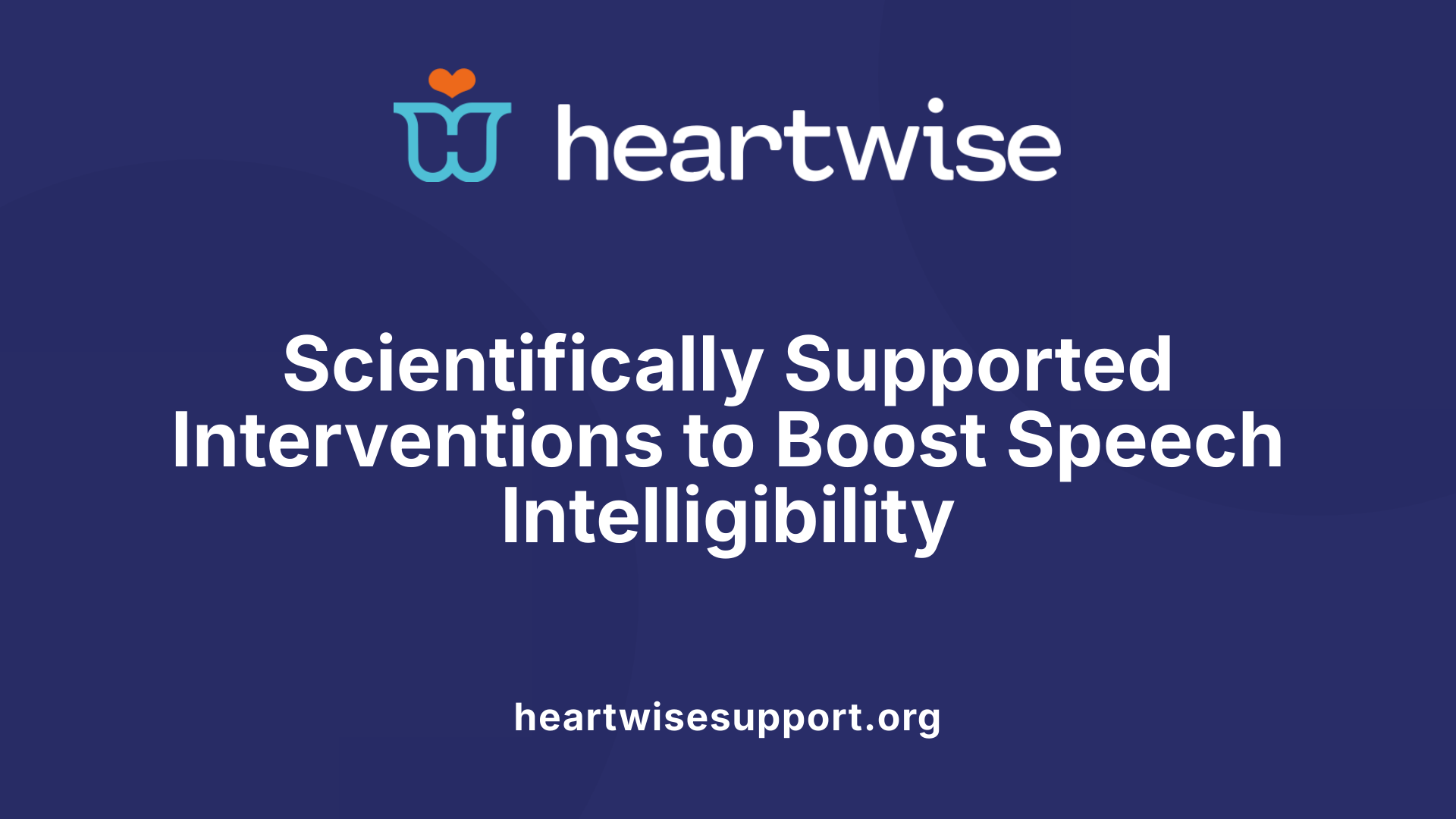Understanding Speech Intelligibility and Its Importance
Speech intelligibility refers to how comprehensible a person's speech is to others. It is a fundamental aspect of effective communication, impacting social interaction, education, and employment opportunities. Developmentally, children typically reach near-complete intelligibility by age 6 or 7, with most achieving 75-90% clarity by age 5. For adults with speech disorders, improving intelligibility is crucial for personal and professional confidence and success.
Core Principles of Speech Clarity and Assessment

What is the definition of speech intelligibility?
Speech intelligibility refers to how comprehensible a person's speech is to others. It indicates the percentage of words or sounds that listeners can accurately understand during communication. High intelligibility typically means most words are understood easily, while low intelligibility suggests that speech is difficult to interpret. It is influenced by the clarity of articulation, phonological accuracy, voice quality, prosody, and speech rate.
How is speech intelligibility assessed and evaluated for progress?
Assessment of speech intelligibility involves various methods. Standardized tests and informal speech samples are commonly used. Clinicians often employ tools like the Intelligibility in Context Scale (ICS) and carry out word-identification tasks with unfamiliar listeners to objectively measure how much of the speech is understood.
Qualitative judgment scales help rate overall clarity and listener comprehension. Specific metrics like the Percentage of Consonants Correct (PCC) analyze error patterns in speech sounds. Additionally, assessments may include evaluation of related language and phonological skills.
Repeated assessments over time track progress, allowing clinicians to refine therapy strategies. These evaluations help determine if interventions are effective and guide treatment adjustments to maximize speech clarity.
What are the age benchmarks and growth patterns?
Children's speech intelligibility develops rapidly during early childhood. By around 2 years, children typically attain 50% to 75% intelligibility. This increases to nearly 100% by age 4. The most significant growth occurs between ages 2;6 to 3;5 months. After age 8 or 9, progress slows, with the annual increase averaging about 3%.
Maximum intelligibility at around age 9-10 can reach approximately 93% at a single-word level. These benchmarks are based on research involving primarily English-speaking children from similar socio-economic backgrounds, and individual variation is common.
What factors influence speech clarity?
Several factors impact how clearly a person’s speech is understood:
- Articulation: The precision of producing individual sounds.
- Phonological skills: The ability to organize sounds into correct patterns.
- Voice quality: Tone, pitch, and vocal loudness.
- Prosody: The rhythm, stress, and intonation of speech.
- Speech rate: Speed of speech; speaking too fast can reduce intelligibility.
- Other influences: Fatigue, emotional state, and recent waking can also affect speech clarity.
Improving speech clarity often involves addressing these interconnected areas through targeted therapy, practice, and environmental adjustments.
Effective Strategies and Techniques in Speech Therapy
 To enhance speech intelligibility, therapists employ a variety of targeted strategies and techniques. One fundamental approach involves articulation exercises and speech drills designed to improve the accuracy of individual sounds. Using visual and tactile cues, such as PROMPT therapy—where physical prompts guide correct speech production—can significantly facilitate proper articulatory movement.
To enhance speech intelligibility, therapists employ a variety of targeted strategies and techniques. One fundamental approach involves articulation exercises and speech drills designed to improve the accuracy of individual sounds. Using visual and tactile cues, such as PROMPT therapy—where physical prompts guide correct speech production—can significantly facilitate proper articulatory movement.
In addition to these exercises, certain principles are crucial for clearer speech. Pausing between words and emphasizing over-articulation, often referred to as “talk BIG,” helps both the speaker and listener. Slowing down speech rate and incorporating deliberate pauses make spoken words easier to understand. Furthermore, increasing volume through “talk LOUD” techniques not only projects speech but also aids in controlling speech pace and pronunciation.
Breathing control and volume regulation are also vital components of speech therapy. Techniques focused on diaphragmatic breathing ensure adequate airflow and support, resulting in clearer, more consistent speech production.
Practicing speech in functional contexts is highly effective. Activities like reading aloud, engaging in conversational exercises, and performing communication tasks that simulate everyday interactions help generalize skills outside therapy sessions. Caregivers and family members can support this by practicing these techniques at home during daily routines such as reading stories, playing dialogue games, or conversing during travel.
Personalized intervention plans often address additional factors like prosody, voice quality, and speech rate. Regular assessments by a multidisciplinary team—including speech-language pathologists—monitor progress. Feedback from professionals combined with consistent practice, modeling correct speech, and encouraging self-monitoring foster gradual improvement.
Rephrasing sentences, introducing new topics, and encouraging the child to articulate words slowly and clearly can make a large difference. The combination of these strategies aims to improve not just the clarity of speech, but also confidence and communication effectiveness, helping individuals participate more fully in social, educational, and professional settings.
Evidence-Based Practices for Enhancing Speech Clarity

What are evidence-based practices and intervention approaches for enhancing speech clarity?
Evidence-based practices in speech therapy involve using assessment tools and treatment methods that have been scientifically validated through research. These approaches help ensure that therapy is effective and tailored to the individual needs of each client.
Key intervention techniques include phonological awareness training, which helps individuals recognize and manipulate sounds in words, and motor speech exercises aimed at improving coordination of speech muscles. Behavioral techniques, such as reinforcement strategies, are also used to encourage correct speech production.
Specific therapies like PROMPT (Prompts for Restructuring Oral Muscular Phonetic Targets) focus on improving speech motor control through tactile cues and manual guidance. The Lidcombe Program, chiefly used for stuttering, employs behavioral reinforcement to reduce disfluencies and improve fluency.
In addition, traditional articulation therapy works on developing specific sounds, while phonological processing interventions address sound pattern errors. Fluency shaping techniques, which modify speech rhythm and rate, further enhance clarity.
Pragmatic social communication interventions improve the functional use of speech in social contexts, helping clients with conversational skills and non-verbal cues.
Clinicians adapt these approaches based on ongoing evidence and incorporate input from clients and their families. Staying informed through reputable organizations such as the American Speech-Language-Hearing Association (ASHA) helps practitioners select appropriate, scientifically supported strategies.
Combining these research-backed methods with clinical expertise and client preferences ensures that therapy is not only effective but also ethical and tailored to meet individual goals.
Speech Therapy Options for Children with Developmental and Speech Sound Disorders
What options and methods are available in speech therapy for children with speech sound disorders or developmental speech issues?
Children facing speech sound disorders have a variety of therapy options tailored to their needs. Approaches such as articulation therapy focus on improving the precise production of individual speech sounds. Phonological pattern therapy targets underlying sound systems, helping children recognize and produce consistent sound patterns. Motor-based techniques, including speech motor chaining and biofeedback, emphasize improving the coordination and strength of speech muscles.
Throughout therapy, clinicians often utilize imitation and modeling to demonstrate correct speech. Visual cues, such as pictures or videos, can support understanding, while tactile feedback—like touch or gentle pressure—helps children feel how to position their mouths properly.
Technology plays an increasing role in modern speech therapy. Ultrasound imaging allows children to visualize tongue movements, fostering better placement. Computer programs and apps provide interactive practice, tracking progress while making learning engaging.
Therapies are conducted in controlled environments like clinics and also within natural settings, such as homes or schools. This encourages children to practice their speech in real-life situations, promoting generalization of skills.
Addressing co-occurring issues, such as pragmatic language skills or other developmental delays, is also essential. Integrating social communication exercises enhances not only speech clarity but also social participation.
Overall, evidence-based, individualized strategies that incorporate multiple techniques, cues, and tools offer the best chance of improving speech intelligibility. By combining these methods, therapists aim to help children communicate effectively, confidently, and socially integrated.
Interventions for Children with Motor Speech Disorders like Apraxia and Dysarthria
What are specific speech therapy strategies for conditions such as childhood apraxia of speech and dysarthria?
Children with motor speech disorders such as childhood apraxia of speech (CAS) and dysarthria require targeted, evidence-based interventions to improve their communication abilities. For CAS, therapy focuses on motor planning exercises to help children sequence speech movements more effectively. Techniques such as PROMPT (Prompts for Restructuring Oral Muscular Phonetic Targets) utilize tactile cues to enhance motor planning, while kinematic approaches analyze the movement of speech articulators to optimize sequencing.
Dysarthria management centers around strengthening the oral musculature, improving speech rate, and increasing overall clarity. This involves exercises to enhance muscle control and coordination, as well as modifying speech rate by slowing down speech and incorporating sensory cues, visual aids, and gestures to facilitate clearer articulation.
Repetition and engaging activities play a key role across both conditions. Activities such as singing, reading aloud, and using fun, interactive exercises help sustain motivation and reinforce new skills. Family involvement and early intervention are crucial; involving caregivers in practice sessions ensures consistent practice at home, which significantly boosts progress.
The emphasis in therapy is on personalized, multisensory approaches that address the child's specific needs, aiming to improve motor control, sound sequencing, and overall intelligibility. Starting intervention early and maintaining consistency are vital to achieving the best outcomes in motor speech development.
Developmental Milestones and Age Expectations for Intelligibility
Typical age benchmarks for intelligibility
Children’s speech development follows a general pattern, with increasing clarity as they grow. By around age 2, many children are understood about 50% of the time, and this improves rapidly in early childhood. Most children reach 75% to 90% intelligibility by age 4, meaning that most adults can understand their speech most of the time.
This progression reflects improvements in articulation, phonology, and language skills, which all contribute to how easy or difficult it is to understand a child's speech. Simple, familiar words tend to be clearer early on, while more complex sounds and sentence structures develop later.
Progression to full intelligibility by ages 6 or 7
Most children are expected to be fully understandable without significant difficulty by around age 6 or 7. By this age, they typically produce speech sounds correctly and use language effectively in social contexts. Their speech is closely aligned with age-appropriate norms, making their communication efforts easier in daily interactions.
At this stage, children’s speech is largely intelligible, though minor errors or accents may still be present but usually do not interfere with understanding. Continued exposure and practice help refine speech clarity as they grow.
Factors affecting individual variability
It is important to recognize that individual differences influence the pace of speech development. Factors such as hearing ability, speech sound development, oral-motor skills, language exposure, and even developmental conditions like speech sound disorders can cause some children to develop speech clarity more slowly.
Environmental factors also play a role; children who have rich language environments and receive speech-language therapy if needed tend to reach developmental milestones sooner. Conversely, children with additional challenges may take longer to achieve full intelligibility.
Slowing of progress after age 8-9
Research indicates that improvements in speech intelligibility tend to slow significantly after age 8 or 9. While children continue to refine their speech, the growth rate drops to about 3% increase per year. Despite the slowing, ongoing improvement is typical into adolescence and even adulthood.
Maximum intelligibility at the single-word level in children aged 9;6 to 10 years is estimated to be around 92.8%. This indicates that, although most children have developed clear speech by then, small residual errors may still occur, especially in connected speech or complex contexts.
Understanding these developmental patterns helps speech-language Pathologists plan appropriate interventions and set realistic goals for children at various ages. Recognizing individual differences ensures tailored support to help each child communicate effectively.
| Age Range | Expected Intelligibility Level | Notes |
|---|---|---|
| 18 months | Around 25% understood | Early speech begins to develop |
| 2 years | 50-75% understood | Vocabulary growth accelerates |
| 3 years | 50-75% understood | Development continues |
| 4 years | 75-90% understood | Near adult-like speech |
| 6-7 years | Close to 100% understood | Full intelligibility achieved |
| 8-9 years | Slight improvements, ~92.8% | Growth slows down |
| Adolescence and beyond | Continued refinement | Small residual errors possible |
Searching for detailed milestones can provide further insight into typical speech development patterns across childhood.
Goals and Progress Monitoring in Speech Therapy
What are the typical goals for improving speech intelligibility in speech therapy?
In speech therapy, the primary objectives are to help children produce clearer, more accurate speech that is appropriate for their age. Goals often include enhancing the articulation of individual sounds, improving overall speech clarity, and fostering effective communication skills in everyday situations.
Goals are designed to be SMART—specific, measurable, attainable, relevant, and time-bound. This approach ensures that progress can be objectively tracked and that therapeutic activities remain focused on meaningful improvements. Practitioners also aim to boost vocabulary, grammatical skills, and social communication, recognizing that these aspects contribute significantly to intelligibility.
Progress is carefully monitored through various tools such as formal assessments, analysis of speech samples, and observations from parents and caregivers. Regular feedback helps therapists adjust treatment plans to match the child's evolving needs.
Adjustments may involve increasing or shifting focus on particular speech sounds, incorporating targeted language activities, or emphasizing social skills depending on the child's developmental stage and therapy outcomes. The ultimate goal is to achieve sustainable improvements that facilitate more effective and confident communication in everyday life.
Resources, Guidelines, and Support for Clinicians and Caregivers
There are numerous resources and guidelines available to support both clinicians and caregivers in improving speech intelligibility. The American Speech-Language-Hearing Association (ASHA) offers detailed practice guidelines, assessment tools, and evidence summaries that help clinicians develop effective intervention strategies. These resources ensure that therapy is based on the latest research and best practices.
For families and caregivers, practical home-based strategies are highlighted in various online resources and professional guidelines. Techniques such as modeling slow speech, correcting errors, and encouraging practice through everyday activities like reading aloud or conversational games can make a significant difference.
Technology plays a crucial role in supporting speech improvement. Speech recognition apps, video feedback tools, and augmentative communication systems provide interactive ways to practice speech sounds and monitor progress. These tools can be used both during therapy sessions and at home, increasing practice frequency and engagement.
Ongoing education and professional development are vital for staying updated with new methods and research. Many online platforms, webinars, and professional communities offer continuous learning opportunities. These forums enable clinicians and caregivers to share experiences, ask questions, and access the latest evidence, fostering personalized and effective communication interventions.
In summary, structured resources from reputable organizations, combined with caregiver involvement and advanced technologies, create a comprehensive support system for enhancing speech intelligibility. Access to current guidelines and tools ensures that intervention strategies are effective, tailored, and sustainable.
Moving Forward with Clearer Speech
Improving speech intelligibility through targeted, evidence-based therapy can significantly enhance individuals’ ability to communicate effectively, boosting their confidence and social participation. A multidisciplinary, personalized approach that involves assessment, therapy, caregiver involvement, and ongoing monitoring ensures sustainable progress. Resources and training for clinicians and families support continued success, paving the way for clearer, more effective communication in everyday life.
References
- [PDF] Strategies for improving speech intelligibility
- Improving speech, language and communication: speech intelligibility
- How to Rapidly Improve Severely Low Speech Intelligibility
- Boosting Your Child's Speech: Understanding Intelligibility Strategies
- Improving Speech Intelligibility in Adults: Clinical Application of ...
- Say It Strong—and Say It Again - The ASHA Leader
- Speech intelligibility in toddlers and children—Here's the intel
- [PDF] Improving Speech Intelligibility in Children with Childhood Apraxia ...











